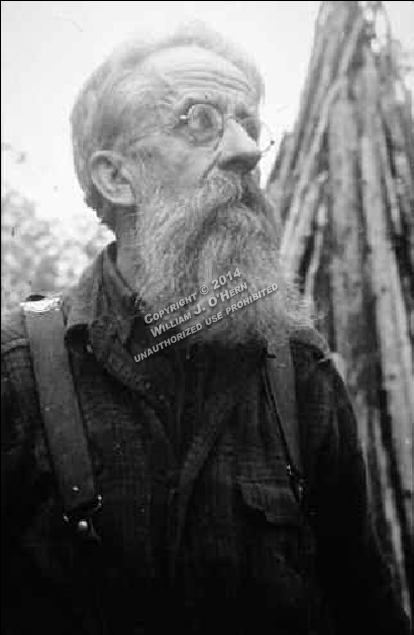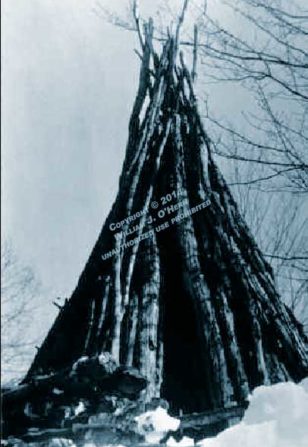“Now it was my turn to inquire about Rondeau’s writings. He certainly had ample enough opportunity to give Thoreau some stiff competition in the literary-hermit field

The Hermit and Us – Our Adirondack Adventures with Noah John Rondeau
Rondeau’s Writings
An excerpt from “The Hermit and Us”, Starting on page 212
Seated in the small, snug cabin made partly of logs, partly of rough sawn boards Noah salvaged from a deserted lumber shanty, Ed thought of his buddy waiting in an adjacent wigwam that provided a camping place for hikers, fishermen, and hunters who came this way and wanted to bed down on the bluff above Cold River. Jack was no doubt studying the pole structures and had discovered they served as Rondeau’s woodpiles, as Ed was gearing up to learn a few things that were still on his mind.

Courtesy of Peggy and Wayne Byrne
Noah’s method of drying firewood stacked into wigwams added to Cold River Hill’s mystique. Each mass had a name: Beauty Parlor, Mrs. Rondeau’s Kitchenette, Meat Wigwam, Pyramid of Giza, Summer Wigwam.
“Now it was my turn to inquire about Rondeau’s writings. He certainly had ample enough opportunity to give Thoreau some stiff competition in the literary-hermit field—if he wanted to work at it. Rondeau claimed he made almost daily entries in his diary. I was dismayed when he told me that much of his writings were in coded hieroglyphics.
“Next, Rondeau brought out one of his coded books. I looked at it and wondered why anyone would spend so much time writing something no one else could decipher unless it was to describe the location of a hidden treasure. So I asked what the purpose of writing in code was if its value dies with its creator. ‘It’s so no one else can read it,’ was Rondeau’s curt reply. Evidently he did not think it an onerous and senseless way of keeping things to himself. Maybe they were not worth reading. On the other hand, maybe they were directions to cached traps and overnight camps, great fishing holes, set locations for taking fur bearers or special deer hunting watches. Maybe, it was just a game he was playing with people so they could always have something to talk about. He also mentioned that he was working on his autobiography. Of course, he would want others to read his autobiography, so it would not be coded. That he would produce a finished literary work of any kind in this primitive environment would be highly commendable, I thought.
“Twenty years after my visit, part of Rondeau’s literary legacy became known to the world when Maitland De Sormo of Saranac Lake published the book Noah John Rondeau, Adirondack Hermit. The book contains Rondeau’s “Recollections of Sixty Years,” excerpts from his journals, and some of his colorful poems, all more or less untouched to preserve the rustic flavor of the self-educated man. I promptly bought one. It is still one of the best-selling Adirondack books about a genuine lover of the wilderness.
Before leaving the hermitage, Rondeau gave us a final tour of his tiny municipality in the wilderness. The many bones and skulls hanging from buildings or laying on the ground he identified as those of deer and bear and various fur bearers. Unlike Thoreau, this hermit was a hunter and trapper, a good rifle shot and something of a bowman who crafted his own bow and arrows. Thoreau, however, had a good eye for finding ancient arrowheads on his many walks.”